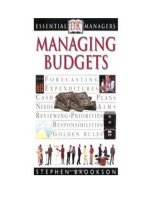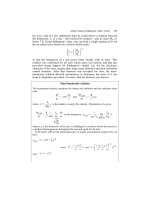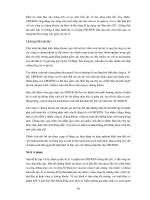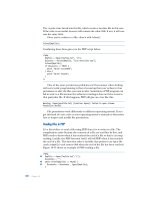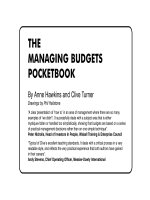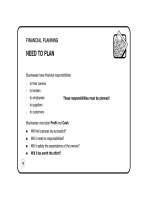THE MANAGING BUDGETS POCKETBOOK phần 8 ppsx
Bạn đang xem bản rút gọn của tài liệu. Xem và tải ngay bản đầy đủ của tài liệu tại đây (86.22 KB, 11 trang )
PRODUCT COSTING
UNDERSTAND THE SYSTEM
PRODUCTION OVERHEAD
What are the production overheads?
- the running costs of the manufacturing department including wages, salaries
and expenses *
How are the production overheads attributed to products? This is the tricky bit!
- How much electricity did we use for Product A?
- How much of the managers’ costs should be charged to each product?
- How much maintenance cost should be charged to Product B? etc
Accountants use the 3 A’s Allocation
Apportionment
Absorption
* Note: The non-manufacturing departmental costs are often excluded from the product
costing system. This can be dangerous! (see page 87)
76
PRODUCT COSTS
UNDERSTAND THE SYSTEM
OVERHEADS: ALLOCATION
● The Production process is divided up into areas of similar types of activity
called Cost Centres
● These could be, eg: machining, assembly, repair
● Each type of production overhead cost is then allocated or apportioned to the
cost centres to arrive at an overhead cost for each cost centre
77
Expense Basis of charge Machining Assembly Repair Total
£’000 £’000 £’000 £’000
Indirect Labour 300
Depreciation 270
Maintenance 160
Indirect Materials 60
Power 50
Rent 160
TOTAL 1,000
PRODUCT COSTING
UNDERSTAND THE SYSTEM
OVERHEADS: ALLOCATION AND APPORTIONMENT
● Wherever possible overheads are allocated to the cost centre consuming the
resources, eg: if each cost centre has different supervisors, their salaries can be
allocated to the centre in which they work
● Certain overheads will not be capable of allocation, eg: rent, power,
personnel services
● An appropriate method of sharing these between the relevant cost centres must be
found, ie: apportionment
Example: power - machine rating x machine hours
rent - area occupied
personnel - number of employees
Be rational. Don’t waste money trying to allocate small sums accurately only to
apportion large amounts!
Focus on the dominant costs!
78
PRODUCT COSTING
UNDERSTAND THE SYSTEM
OVERHEADS BY COST CENTRE
The tabulation analysing all overheads by cost centre can now be completed.
79
Expense Basis of charge Machining Assembly Repair Total
£’000 £’000 £’000 £’000
Indirect Labour Allocation 160 80 60 300
Depreciation Allocation 160 30 80 270
Maintenance Allocation 80 30 50 160
Indirect Materials Allocation 15 20 25 60
Power Apportionment 25 5 20 50
Rent Apportionment 60 35 65 160
TOTAL 500 200 300 1,000
PRODUCT COSTING
UNDERSTAND THE SYSTEM
OVERHEADS: ABSORPTION
● The costs of each cost centre are then charged out to the products using an
overhead absorption rate
● The traditional approach is to use a
labour hour rate, or machine hour rate
Step 1 Establish the overhead costs allocated/apportioned to the cost centre,
eg: £500,000
Step 2 Determine the number of labour (or machine) hours to be produced by the
cost centre in the year, eg: 20,000
Step 3 Calculate the overhead hourly rate, eg:
£500,000 = £25/hour
20,000
Step 4 Charge products with overhead according to the number of hours’ work
required in the cost centre, eg:
1/2 hour £12.50 overhead
80
PRODUCT COSTING
UNDERSTAND THE SYSTEM
EXAMPLE
● You are invited to tender for a contract to supply Product X
● Product X will require: Direct materials £50
Direct labour 7 hours
● Your Production Budget shows: Total Production overheads £600,000
Planned labour hours 15,000
Planned direct wages per hour £5
● You calculate your overhead absorption rate: £600,000 = £40/hour
15,000 hours
This information would play a key
role in the tendering process.
Is it correct? Or could there be
other answers - see Appendix Two.
81
£
Direct material 50
Direct labour (7 hours x £5) 35
Production overhead: 7 hours x £40/hour 280
Product cost 365
PRODUCT COSTING
STEP 2: CHALLENGE THE SYSTEM
● Look at your own costing system
● Is it deficient?
● Here are some classic indicators of problems:
- ‘easy’ products are reported to be loss-makers
- ‘difficult’ products are reported as highly profitable
- competitors seem unable to match your low prices
- competitors continually under-cut you
- cost information is ignored/disbelieved
- departmental PC based information is
compiled to provide ‘true costs’
82
PRODUCT COSTING
CHALLENGE THE SYSTEM
YOU ARE UNIQUE!
The following pages identify some of the areas to start looking at, when you challenge
your own product costing system.
● The costing system should trace resources through to products (see page 71)
● No two companies use identical resources in exactly the same way to make the
same products
● Hence no two costing systems should be the same!
Is your system tailored to reflect what goes on in your business?
83
PRODUCT COSTING
CHALLENGE THE SYSTEM
WHO WROTE IT?
● The costing system should trace resources through to products
● Who knows this process best? Probably not the accountant!
But who wrote the costing system?
● How often do you change the resources, processes or products?
How often does the costing system change?
● The management accountant produces cost information to facilitate decision-making
Does it really help you take better decisions?
84
PRODUCT COSTING
CHALLENGE THE SYSTEM
OVERHEADS
● Product costs will be affected by:
- number and definition of cost centres
- basis of apportioning costs
- method of absorption
Has sufficient thought been given to the choices in your system?
A detailed example of the effect this can have on the product cost is given
in Appendix Two
85
PRODUCT COSTING
CHALLENGE THE SYSTEM
BELOW-THE-LINE COSTS
● Most costing systems treat direct materials, direct labour and production overhead as
product-related, whereas other operating costs (expenses) are deemed to be non
product-related
● These expenses are often referred to as ‘below-the-line’, ie: below gross profit
● This results in profit reports which only identify product profitability at the
Gross Profit stage
Example
● The business wishes to
focus its product range
● Which product should it
drop, A or B?
● What effect will it have
on operating profit?
86
A B Total
£££
Sales 100 100 200
Less:
Cost of Goods Sold 70 50 120
Gross Profit 30 50 80
Expenses:
Admin 10
Selling 20
Service 30
Operating Profit 20
